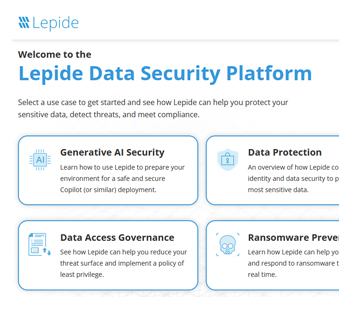Last Updated on February 4, 2025 by Deepanshu Sharma

An increasingly digitalized environment contains vast volumes of data that can provide important insights and guide decision-making. Data is available in many formats. Every organization is seeing an unprecedented increase in the amount of data it collects. According to a study unstructured data is expanding at an astounding speed, three times quicker than structured data. So, what is unstructured data, and how do you make sure you get the most from it, without compromising security?
What is Unstructured Data?
The term “unstructured data” describes sensitive information that lacks a set format or structure. Unstructured data does not have a specific format and is commonly present in emails, social media posts, audio files, photos, videos, and free-form text documents. Let us consider a desk that is overflowing with printed articles, handwritten notes, drawings, and photographs. This disarray of data is comparable to unstructured data in that it contains a lot of content that isn’t instantly usable without being categorized or sorted.
Unstructured data can be divided into two categories:
- Human-Generated Unstructured Data: This refers to the different types of material, such as emails, social media posts, and text documents.
- Machine-Generated Unstructured Data:The term “machine-generated unstructured data” refers to information produced by sensors and devices, such as log files, GPS data, Internet of Things (IoT) output, and other data.
Unstructured Data Examples
Numerous unstructured data formats and types exist, and they differ greatly in terms of the information they contain and the way they store it. The list of unstructured data examples is provided below.
- Text Documents: These are textual documents that don’t follow a set format. Narratives, descriptions, and other textual communications may be included in the content.Unstructured data includes things like plans (.txt), Microsoft Word documents (.doc), PDF files (.pdf), HTML files (.html), and other word processing materials.
- Emails: Email is a type of electronic communication that includes unstructured data and a variety of file attachments, including spreadsheets, documents, and photos.
- Social Media Posts: There is no set structure to the text, photographs, and other multimedia information found in data from social media sites like Facebook, Twitter, and messaging apps.
- Multimedia Files: Images and videos may lack explicit labeling or categorization, while audio files can contain spoken words or other sounds without a predefined structure. Audio data is usually presented in formats such as MP3 (.mp3), WAV (.wav), and FLAC (.flac), to name a few. These files contain sonic information that requires audio processing techniques to extract meaningful insights. Video data comes in popular formats such as MP4 (.mp4), AVI (.avi), MOV (.mov), and others.
Structured Data VS Unstructured Data
Data can be classified as semi-structured, unstructured, or structured based on specific characteristics. Structured data is typically organized according to a predefined data model in relational databases. All of this data is organized in tables with rows and columns, and each piece of content is grouped into a suitable, well-defined, and targeted field. This setup lays the groundwork for natural language by making it simple for machines and humans to search, retrieve, and evaluate structured data.
Unstructured data outlines the constraints of particular data models, as contrast to structured data, which does not have a set organizational structure. It is impossible to store in an RDMS because it has a diverse range of formats and no consistent internal structure.
Risks Associated With Unstructured Data
Despite the fact that unstructured data requires creativity and adaptability, there are a number of hazards and difficulties involved. The list of the main dangers connected to unstructured data is provided below.
- Data Leakage: Internal users and malicious actors pose a serious threat to data risk. Unstructured data contains many important bits of information. Either intentionally or unintentionally, workers reveal information. This would put the organization’s reputation and compliance at serious risk. When generative AI output or staff conduct exposes critical data to the public, the firm is at risk. Data leakage may result from employees’ malicious or unintentional access to or sharing of unstructured data.
- Data Breaches: Because unstructured data may be scattered over several sites, it is especially vulnerable to data breaches and unwanted access. Unstructured data frequently contains private information including financial data, intellectual property, and personal data. It can be susceptible to data breaches if appropriate security measures are not put in place.
- Regulatory Compliance: Unstructured data frequently contains significant resources such as competitive intelligence and private customer information. Violations of data privacy laws may have major financial and legal repercussions. Data handling must adhere to regulations including the CCPA, GDPR, and HIPAA. Not recognizing or managing unstructured data could have serious repercussions. It could be challenging for the business to demonstrate
Challenges within Unstructured Data
- Non-Compliance Risks: Failure to comply with employee demands for information retrieval and deletion may harm a company’s reputation. How can companies continue to adhere to privacy regulations? by giving staff the freedom to locate and inspect untagged data and prioritizing its discovery. Laws pertaining to privacy and data protection have grown more strict over time, and violations now carry severe penalties. A data breach caused by inadequate security measures could lead to the loss of private information, including customer data. If unstructured data is used for marketing, the consent acquired during data collection may become less legitimate. To illustrate a software’s capabilities, for example, using actual client invoices is a privacy violation that could result in legal action. Data related to unrelated topics may be kept in secondary storage. According to privacy standards, companies must keep sensitive data in their primary storage.
- Lack of Visibility: Without knowing the location, sensitivity, and severity of the data, no organization can safeguard it. This might result in security threats that could jeopardize the unregistered data. The increasing amount of unstructured data has raised privacy and security concerns, which could result in impending cyberattacks. When an organization deals with a lot of data, they often forget about the data they possess, the people who have access to it, and the security measures that are in place to secure it. Organizations expose their systems and resources to risks such as unintentional security breaches, data leaks, and privilege misuse as a result.
- Data Security Risks: Numerous unstructured data sets contain sensitive information, including personally identifiable information (PII) and personal information (PI). Accidental disclosure of this data is always a possibility. Data privacy is compromised if GenAI models are trained on sensitive data, which stays with them indefinitely. Additionally, a variety of dynamic proprietary unstructured data is frequently used by enterprise GenAI apps, which raises privacy, security, and governance issues.
- Data Storage and Management: Managing and storing unstructured data is one of the main obstacles to overcome. In contrast to structured data, which is neatly organized into rows and columns, unstructured data can be found in a wide range of formats, including social media content, text, video, and audio. It is challenging to store this diversity in conventional relational databases. Businesses must figure out how to store this data effectively, which frequently means making huge expenditures in storage systems that can manage massive data volumes and a range of data kinds. Effectively managing this data to make it accessible and usable is also a challenging endeavor that frequently calls for sophisticated data management techniques and systems.
- Data Storage and Management: Managing and storing unstructured data is one of the main obstacles to overcome. In contrast to structured data, which is neatly organized into rows and columns, unstructured data can be found in a wide range of formats, including social media content, text, video, and audio. It is challenging to store this diversity in conventional relational databases. Businesses must figure out how to store this data effectively, which frequently means making huge expenditures in storage systems that can manage massive data volumes and a range of data kinds. Effectively managing this data to make it accessible and usable is also a challenging endeavor that frequently calls for sophisticated data management techniques and systems.
Strategies For Protecting Unstructured Data
Effective methods and best practices should be implemented by enterprises to reduce the hazards connected with unstructured data. The following are important tactics to think about:
- Data Discovery and Classification: Start by classifying your unstructured data based on its level of sensitivity. Implementing Data Discovery and Classification tools can also help your organization’s unstructured data become more valuable, helpful, and effective. A single source of truth for unstructured data allows for consistent permission, privacy, quality, and compliance standards across all security controls and silos, which improves data security governance. Simplifying the process of scaling data infrastructure and providing a flexible foundation for future developments. To boost productivity and save expenses, eliminate redundant and duplicative work that involves locating and processing the same data for multiple products.
- Employee Awareness and Training: Best practices for managing data and the significance of safeguarding sensitive unstructured data should be taught to staff members. Encourage staff members to understand their roles and to exercise caution when it comes to protecting sensitive data. Employees should be instructed in appropriate data management procedures and the value of safeguarding sensitive unstructured data.
- Continuous Monitoring and Auditing: Another strategy for protecting unstructured data is to have monitoring and auditing procedures in place to spot any unusual activity or illegal access. Review access logs frequently and use real-time alerting to react quickly to any security issues. Activity logs and data access need to be regularly monitored in order to determine who is accessing, altering, or exporting unstructured data. Any odd behavior or access patterns that can point to illegal access or data leaking should set off alarms
- Don’t depend on a Single Solution: There isn’t a single strategy that works for everyone when it comes to managing unstructured data. Managing your unstructured data may become less effective if you rely too much on the built-in features of Azure or other cloud infrastructures. The best option is to combine your cloud architecture with third-party solutions that offer comprehensive DAG and data search and classification capabilities. Although it may seem more complicated, combining controls from many systems is the most effective strategy to optimize your data management. Waiting for a one-size-fits-all solution will only result in delays, greater operational complexity, and continuous data risk.
- Data Encryption: Another challenge with unstructured data is selecting the appropriate Data encryption methods and key length. Even though a longer key length might increase security and reduce the likelihood of key compromise, it can also degrade performance and require more time and resources. Because of this, selecting an encryption method and key length necessitates a deep comprehension of the company. Sensitive unstructured data must be encrypted both in transit and at rest to prevent unauthorized access. To ensure data integrity and confidentiality, use industry-specific standard algorithms and key management practices.
How Does Lepide Help?
The Lepide Data Security Platform is designed to simplify unstructured data protection . By integrating identity and data protection into a single platform that enables comprehensive monitoring and quick response to threats, Lepide guarantees the security of sensitive data. Our platform’s simple design allows companies to easily reduce risk and protect data across on-premises and cloud platforms without the need for siloed solutions or extensive technical knowledge.
The ideal of effective, efficient, unstructured data security can become a reality by selecting Lepide, which will help you make better decisions more rapidly and efficiently and lead you to a future where your risks are reduced and your data is safe.
Schedule a demo today and Say Goodbye to complexity and make the goal of efficient, effective, unstructured data protection a reality.


 Group Policy Examples and Settings for Effective Administration
Group Policy Examples and Settings for Effective Administration 15 Most Common Types of Cyber Attack and How to Prevent Them
15 Most Common Types of Cyber Attack and How to Prevent Them Why AD Account Keeps Getting Locked Out Frequently and How to Resolve It
Why AD Account Keeps Getting Locked Out Frequently and How to Resolve It
